Datsun Truck
The Datsun Truck is a compact pickup truck made by Nissan in Japan from 1955 through 1997. It was originally sold under the Datsun brand, but this was switched to Nissan in 1983. It was replaced in 1997 by the Frontier and Navara. In Japan, it was sold only in Nissan Bluebird Store locations.
| Datsun Truck | |
|---|---|
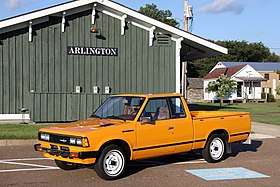 | |
| Overview | |
| Manufacturer | Nissan (Nissan Shatai) |
| Production | 1955–1997 |
| Model years | 1956–1997 |
| Body and chassis | |
| Class | Compact pickup truck |
| Layout | FR layout |
| Chronology | |
| Predecessor | Datsun 6147 |
| Successor | Nissan Navara |
Predecessors

The Datsun truck line began with the Type 13 Truck of April 1934, and was later used as the basis of the Datsun DC-3 roadster. A series of small trucks based on their passenger car counterparts, the 14T, 15T, and 17T, continued to be built until early 1944.[1] This was followed by the post-war Datsun 1121 (1946), which was nearly identical technically but had an extremely simple body made out of simple pressed metal (with almost no chrome) and many body parts made from wood, to enable production in resource-starved early post-war Japan. As the supply situation improved the new 2124 and 2225 took over in 1947 and 1948. In 1949 the 3135 took over, followed by the January 1950 Datsun 4146 which introduced the 860 cc Type 10 engine with 20 PS (15 kW).[2] The 4146 also marked the return to a more ornate grille (the old 17T piece) with some minor chrome trim included.[3] In 1951 the 5147 appeared, introducing a longer wheelbase of 2,150 mm (84.6 in) rather than the 2,150 mm (84.6 in) chassis which had been used for seventeen years.[2] This was succeeded two years later by the 6147, which received a 25 PS (18 kW) version of the Type 10 engine thanks to higher compression rates being made possible.[2] Although somewhat longer and with a bigger engine, the Datsun 6147 remained nearly identical to the prewar type 15 truck. This was built until the 1955 introduction of the all new 120-series truck.
Datsun 120
| Datsun 120/220 | |
|---|---|
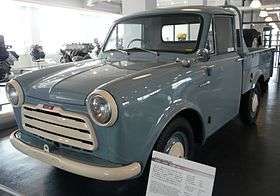 Datsun 220 | |
| Overview | |
| Production | 1955–1961 |
| Model years | 1956–1961 |
| Assembly | Nissan Shatai, Hiratsuka, Kanagawa, Japan |
| Body and chassis | |
| Body style |
|
| Layout | FR layout |
| Related | |
| Powertrain | |
| Engine | |
| Transmission | 4-speed manual |
The Datsun 120 was a load carrying bodystyle version of the Datsun 1000 sedan (110 series), and was introduced in January 1955 as the latest Datsun truck with up-to-date styling. Delivery van, panel van (120 only), and double cab versions were available. Until 1959 it used the 25 hp, 860 cc Datsun Type 10 engine with a four-speed floor shift (column shift for the 123 and later versions) manual transmission. It was joined with a larger commercially focused vehicle called the Nissan Junior.
During its six years in production six main models were built: 120 (Jan. to Dec. 1955), 122 (Dec. 1955 to May 1956) and 123 (Jun. 1956 to Sep. 1957). For reasons unknown, Nissan skipped the 121 designation. After the introduction of the re-engined 220-series truck, a modernized low-cost option, the Datsun 124 was introduced in October 1957. It continued to use the same bodywork and engine as the 123, although with less chrome trim.[4] This was then followed by the re-engined Datsun 125 in 1959 and finally by the Datsun 126 in 1960. While the 124 was still powered by the Type 10 engine, the 125 and 126 received an improved version of this engine called the B-1, rated at 27 PS (20 kW).
Datsun 220
In November 1957 the type 220 was introduced. Largely unchanged in appearance from the 120-series, which continued to be built as a cheaper version, it was produced from 1957 to 1961. During this time four models were produced: 220 (1957–1958), 221 (1958–1959), 222 (1960), and 223 (1961). The chassis was based on the 210 series sedans. Two engines were available: the 37 hp Nissan C engine, and the 48 hp Nissan E engine. The E engine was originally only used in models sold on the export market. The 223 was powered by a new engine, the Nissan E-1, rated at 60 hp. The 220 was the first Datsun truck to be equipped with a 12 volt electrical system. Double cab and delivery van versions were available. Side badges were "Datsun 1000" or "Datsun 1200". The 223 also had a round "60 HP" badge. There was also a round badge on the dashboard that said "Datsun 1000" or "Datsun 1200", depending on the engine. The 223 had a revised chassis and suspension system. The front I-beam suspension used on the 220, 221 and 222 was replaced with an independent front suspension with torsion bars. A long bed version was introduced with the 222. As a low cost option, a lightly changed model of the D10 sidevalve-engined predecessor was introduced in October 1957 (the Datsun 124), followed by the Datsun 125 in 1959 and finally the Datsun 126 in 1960. The 125 and 126 were powered by the B-1, an improved version of the D10 with 27 PS (20 kW).
In 1958 the Datsun 220 was exhibited at the Los Angeles Auto Show, with American exports beginning soon after. It was the 220 series that established Datsun in the American market.
Datsun 320
| Datsun 320 | |
|---|---|
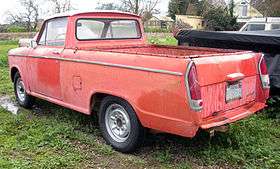 1964 Datsun NL320 | |
| Overview | |
| Production | 1961–1965 |
| Model years | 1962–1965 |
| Assembly | Nissan Shatai, Hiratsuka, Kanagawa, Japan |
| Body and chassis | |
| Body style |
|
| Layout | FR layout |
| Related | Datsun Bluebird S310 |
| Powertrain | |
| Engine | 1.2 L E-1 I4 |
In August 1961 the new 320 series was released. It was produced until 1965 in three series (320–322). The 320 series was largely inherited from the earlier 120/220, although with clear improvements to body and frame. It used the Nissan E-1 engine. This engine produced 60 PS. Nissan updated the larger commercially focused Nissan Junior in 1962.
All Datsun trucks kept the A-arm torsion bar front suspension with leaf-sprung rear ends and had a 1/2 ton load capacity. Rear end gearing was a low 4.875:1 along with a four-speed transmission; as a result, the 320 was not freeway friendly above 60 mph. Fender emblems showed "Datsun 1200" and "60 HP" ("55ps" for models sold in Japan) with a "Datsun" emblem on the front nose of the hood.
Available bodystyles include a single cab "truck" (320), a longer wheelbase single cab truck (G320), a double cab "pickup" with flush sides (U320), and a three-door "light-van" (V320). Though described (and taxed) as a van in the Japanese market, the V320 is essentially a two-door station wagon. The 320 came in two cab and bed versions: Regular, and as the NL320 "Sports Pick-Up" (1963–65) variation which is a rarer (around 1,000 produced) version with the cab and bed of a one-piece design. Its back half is greatly different than that of the standard, separate bed 320 pick-up.
Bed and luggage space were in addition to the expansion, with the support of the market characteristics and the robust chassis engine was easy to handle, it was a best seller in the truck market segment.
The chassis was also a sales hit 310 in the reinforcement of the type Datsun Bluebird 310, a variation of the same series, in which the X-members plus a reinforcement of the Fairlady roadster of the S310-type CSP311. It was also used for the new Silvia coupé.
In 1964 the 320 underwent minor changes. After having adding the failed Light Stout, Toyota took over Hino's Briska and then continued with the Hilux. Mazda also competed in this segment, with the Mazda B-Series. In 1960, Nissan assumed operations of the Minsei Diesel Industries, Ltd., renaming the company as Nissan Diesel Motor Co., Ltd (now UD Trucks).
Datsun 520
| Datsun 520 & 521 | |
|---|---|
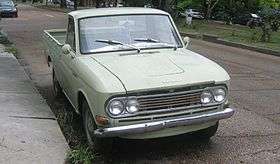 Datsun 1300 | |
| Overview | |
| Production | 1965–1972 |
| Model years | 1966–1972 |
| Assembly |
|
| Body and chassis | |
| Body style |
|
| Layout | FR layout |
| Related | Nissan Bluebird 410 |
| Powertrain | |
| Engine | |
| Dimensions | |
| Wheelbase | |
The Datsun 520 was built from 1965 until May 1968 (the 420 designation was skipped). It used the new 1.3 litre, 67 hp Nissan J13. In 1965 and 1966 the 520 had two single headlights. For 1967, the 520 was slightly redesigned and had twin headlights. This design was carried on until the end of 520 production. Single cab (520, and L520 for left-hand drive version), LWB Single cab (G520), Double cab (U520) and delivery van (V520) versions were available. "G" was used to identify the long wheelbase versions. The fender emblems said "Datsun 1300". A grille emblem was added in 1966 and simply said "D". In late 1967 a slightly altered model appeared, now with a slightly changed chrome grille with a distinct frame.[6]
In 1967, Nissan added the Nissan Sunny pickup truck, which was exclusive to Nissan Saito Store locations, which closely shared the dimensions, engine displacement and load carrying duties of the 520 series truck.
The 521 was the facelifted version of 520, with a so-called "flat-deck" style. This meant a flattened bonnet and front fenders as well as a new grille design.[5] It used the Nissan J engines (the previously mentioned J13 or the larger J15, rated at 77 hp) and later had a 95 PS (70 kW) Nissan L16 engine, always with a straight rear axle. The 520 strongly resembles a Datsun 410/411 from the front, since it shares most sheet metal with that car. The fender emblems said "Datsun 1300", "Datsun 1500" or "Datsun 1600" (depending on engine fitment). Van/delivery van (V521) and double cab (U521) versions were available. It was manufactured from June, 1968–1972, preceded by the 520 and followed by the 620. The 521 was the first compact half-ton pickup sold in the American market, in 1968 .
In 1968, larger load carrying duties were now shared with the Datsun Cabstar, a cabover truck sharing a chassis with the third generation Nissan Junior.
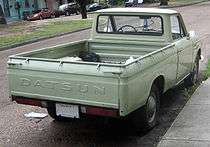 Rear view of Datsun 1300 (520, US)
Rear view of Datsun 1300 (520, US)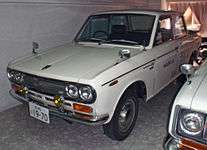 1970 Datsun 1500 double cab facelift (U521)
1970 Datsun 1500 double cab facelift (U521)
Datsun 620
| Datsun 620 | |
|---|---|
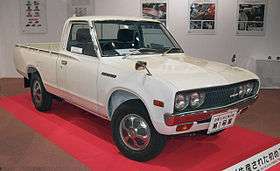 Datsun 620 | |
| Overview | |
| Also called |
|
| Production | 1972–1979 |
| Model years | 1973–1979 |
| Assembly |
|
| Body and chassis | |
| Class | Compact truck |
| Body style |
|
| Layout | FR layout |
| Related | Nissan Bluebird 610 |
| Powertrain | |
| Engine | |
| Transmission | |
| Dimensions | |
| Wheelbase | |
In February 1972, the Datsun 620 truck was released and was in production until 1979. It was a regular cab truck (a longer "King Cab" [Nissan's trademark for their extended cab trucks] version was released in 1977) and two wheelbases were offered, for a total of six different models. There was also a delivery van version, offered only in Japan. Naturally there were bare chassis models, and many importers installed locally made flat decks. There was also the U620, which is a crew cab "Utility" version. It uses a shorter, fully integrated bed to allow comfortably seating four people. The U620 was essentially a 620 pickup from the doors forward, with the bed and rear end being the only difference. Nissan continued the strong rhythms and styling of its previous vehicles, with a shoulder "wing line" or "Bullet Side" accent running alongside the vehicle. In most of the world the 620 was equipped with the J15, producing 77 hp (57 kW) and a claimed top speed of 135 km/h (84 mph).[8] A 2.2 liter diesel engine with 66 hp (49 kW) was later made available in many markets.
The 620 was also the first Datsun pickup truck to be available with a longer "King Cab" passenger compartment (called "Custom" in Japan). This used the bed from the normal 620 truck, but has a cabin stretched by 24 cm (10 in), all placed on the longer wheelbase.[9]
The 620 was redesigned slightly for 1978, with changes to grille and front bumper. The suspension was also revised, increasing track at both ends by 30 mm (1.2 in). This also marked a name change in South Africa, where it had been sold simply as the Datsun one-ton pick-up, to "Datsun 680".[10] A four-door crew cab variant was also offered in some markets.
North America
In North America, the 620 continued to use the Nissan L engine. The 1972 and 1973 models were powered by the L16 engine (96 hp), the 1974 model used the L18 engine (100 hp), and the 1975 through 1979 models used the L20B engine (110 hp SAE Gross).) SAE Net rating was 97 hp (72 kW). This was a "50-state car", with an EGR system for pollution control which sufficed to meet California's stringent emissions standards without a catalytic converter.[11] The 620 was available with two wheelbases and also as the extended King Cab model from 1977. In Canada the 620 was marketed as the "Sportruck",[12] while American buyers knew it as "The Little Hustler". In North America it was generally treated as a regular car, with 40% of buyers stating that they never used the truck for "work".[13] The standard transmissions were the F4W63 four-speed (1972 and 1973) and F4W71 four-speed (1974 to 1979). In 1977, the optional FS5W71B five-speed manual transmission became available. The 3N71 three-speed automatic became available as an option in mid-1972. This was the first series to offer an automatic transmission as an option (all model series before the 620 only had manual transmissions). Final drive gearing was 4.375:1.
Side badges read "DATSUN 1600" or simply "DATSUN". The grille badge was two colored stripes (one red and one blue) behind the word "DATSUN". The 620 was known for its durability and weather resistance despite its small size, along with engines known for their reliability. As a result, the 620 was competing with the larger American pickup trucks, which in turn gave Datsun a strong reputation in the United States. A number of innovations were introduced with the 620: first long-bed (1975),,[14] first extended-cab (1977), front disc brakes (1978), and electronic ignition (1978).
- Gallery
- Datsun U620, a rare Japanese market "Utility" version
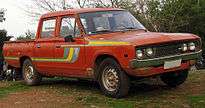 1978 Datsun 1500 Crew Cab
1978 Datsun 1500 Crew Cab_(front)%2C_Kuala_Lumpur.jpg) Datsun 620 "Bullet Side" pickup in Malaysia.
Datsun 620 "Bullet Side" pickup in Malaysia.
Datsun/Nissan 720
| Datsun 720 | |
|---|---|
_01.jpg) 1983–84 Datsun 720 crew cab | |
| Overview | |
| Also called |
|
| Production |
|
| Assembly |
|
| Body and chassis | |
| Body style | |
| Layout | FR layout / F4 layout |
| Related | Nissan Violet 710 |
| Powertrain | |
| Engine | |
| Transmission |
|
| Dimensions | |
| Wheelbase |
|
| Width |
|
In October 1979, Nissan introduced the Datsun 720 as successor to the 620. A four-door crew cab version of the 720 was available in most markets (although not in North America). In addition, some overseas models continued with the early style beds in the later model years as well as the lower cost round headlamps, and included various combinations of Datsun and Nissan badging while retaining the Datsun name throughout all model years. In Japan, round headlights were standard but higher-end models like the GL received square headlamps.[15] In Japan, the standard engine was originally the J16 but in 1982 this was changed to the more modern Z16 derivative.[16]
In 1983, the front end underwent a transformation with a larger grille, bumper, and corner lights. There was also a revised dashboard with round instead of square gauges. At the same time, the regular cab was lengthened slightly and the air extractor vents behind the cab doors changed from the high "flag" look to long, narrow ones that matched the height of the window opening. The cabs of the King Cab versions were unchanged.
Engine and Drivetrain
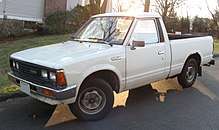
In 1980, US models were powered by Datsun's 2.0L carbureted L20B I4 engine, but soon after switched to the Nissan NAPS-Z engine line for 1981 (Z22S). "NAPS" was the terminology Nissan used to describe their pollution control technology as a result of emission regulation laws having been enacted in Japan, starting in 1975. In the Middle East, it was powered by Datsun's 1.8 L carbureted L18 engine. The 1981–1982 models used the Z22 carbureted 2.2 L engine and an optional SD22 diesel of the same displacement. In mid-1983, Nissan introduced the Z24 2.4 liter twin spark four-cylinder engine, producing 103 hp (77 kW), 2.3 L SD23 OHV diesel four, and the SD25 diesel.

The diesel engines were sourced from the Nissan Diesel division, which Nissan Motors acquired in 1960. This dominated 720 sales in many markets and was also available in combination with 4WD. In the American market, the diesel engine was only available in the 2WD 720 (from 1982 to 1985). The Z24 was upgraded to Z24i single-point fuel-injection for some 1986 ST models. The rest of the world had versions with the smaller 1.5 L J15, 1.6 L J16 or 1.8 L L18 carbureted engines. The 720 Series was never available with any of the Z22E or Z20E multi-port fuel injected engines.
North America
In the US, the 720 came in regular cab and "King Cab" models, with regular and long bed options with standard (GL), deluxe (DX), and "Sport Truck" (ST) trim packages, all of which had two doors. In addition, from 1984 to 1986 a covered utility body style like that of the first generation 4Runner was available as an aftermarket conversion by a company called Matrix3 called the Bushmaster. The Datsun 720 was available in both 2WD and 4WD configurations, the latter having a divorced transfer case. The long wheelbase 2WD trucks (King Cab, short bed, and regular cab, long bed) had a two-piece driveshaft with a center support bearing. The dome light could fold rearward, to provide illumination to the bed.
The 720 was assembled in the newly built Smyrna, Tennessee plant from the 1983.5 model year until 1986. However, Nissan of Mexico continued to build the pickup until 1991, 1992 being its last official model year. They were exported to the whole of Latin America.
The 1980 to 1983 models were called the "Datsun 720". They had single wall beds with outside rolled lips and rope ties, two faux hood vents (some had real vents), and tail lights on the lower rear valance (similar to the 620). These vehicles were badged with a small Datsun logo on the driver's side of the grill, a raised plastic Datsun badge on the front fenders, a large Datsun embossed on the rear tailgate, as well as Datsun stickers on the bottom left of the tailgate, and model designation on the right. The owner's manual and service manuals retained the Datsun name.
For a limited period, 1984 models built in the US had the single wall beds with rope ties, yet used tail lights on the rear bed corners with amber turn signals over the red stop/tail lights while the backup lights remained under the tailgate. These "in-between" models were a combination of Datsun and Nissan badging, with Nissan replacing Datsun in similar fashion to the earlier models, but incorporated a "Datsun by Nissan" plastic trim piece on the front fenders, and "Datsun by Nissan" stickers on the tailgate. The late model trucks produced from 1983.5 to 1986 used double wall, smooth sided beds, with revised tail lights on the corners which resembled those on Chevrolet/GMC S-series trucks. The badging was exclusively Nissan (going along with Nissan's rebranding and conversion of 1,100 Datsun dealerships to Nissan dealerships), with the name officially being "Nissan 720", which is found in the owner's manual, service manual, and literature from the period.
Trim options
Lil' Hustler
This was a continuation of the Lil' Hustler line from the 620 generation. It was a bare-bones truck that was only available as a regular cab with a 1.8 m (6 ft) bed, and was discontinued after 1982.
MPG
Unlike the GL, the MPG model of the Nissan 720 was a stripped-down version of the truck to improve fuel economy. Unlike the others it had only a driver side mirror, single walled bed, vinyl bench seat, and other bare bone accommodations. What really set this model apart was its drive train. It featured the 2.0L Z20 motor that was fed by a carburetor. Its compression ratio was at a high 9.4 to 1, and produced 95 hp (71 kW) and 112 lb⋅ft (152 N⋅m) of torque. It was able to do this because it featured a knock sensor that would retard the timing by about 10 degrees to prevent the engine from knocking. This resulted in excellent fuel economy but at the cost of emissions. For that reason this truck was not sold in the California market.
GL
The standard (GL) single cab Datsun 720 came with a front bench seat made of single color non-patterned cloth and leather in blue, black, or tan to match the interior trim color of the vehicle. It had optional factory air-conditioning and contained a simple gauge cluster with speedometer, fuel, and water temperature gauges (with blank faces in place of the tachometer and clock), as well as sliding glass rear window. A radio and cruise control were options installed by the dealership. These vehicles came in long bed, short bed, or cab-and-chassis styles with the later having a "heavy duty" option of dual rear wheels.
DX
The 2WD deluxe model came with front bench seats of varying patterns to match the door trim and interior in blue, black or tan. 4WD models had two bucket-style seats, and incorporated a center console with voltmeter and oil pressure gauges. Both drivetrain options had single and King Cab variants. These models came with factory air conditioning, an AM-FM radio of two different types, a tachometer and/or a clock in the gauge cluster, an option of either rear sliding windows or single-pane window with defroster, as well as optional cruise control. Beds both long and short were available. In addition, there were roll-bar and bumper-brush guard options for the 4WD variant that were installed by the dealership with mounting points for off-road and fog lights. Switches for these were placed in the center console below (1980 to pre-1983.5) and above (Post 1983.5 to 1986) the voltmeter and oil pressure gauges.
XE
The 2WD Luxury model came only in king cab variants and featured several standard and unique features. For the exterior, it came with a two tone paint job, chrome bumpers, mirrors and grille. It also had Nissan brand hexagonal hubcaps, whitewall tires, and sun roof. For the interior, this top of the line model came with full carpeting, bucket seats, tachometer, quartz clock, intermittent wipers, center console, and woodgrain accents on the dash and door. Like the other trucks, it was powered by the Z24 and offered both a 5-speed manual or 3-speed automatic.
ST
The 2WD and 4WD sport truck package came with factory air-conditioning as well as the clock and tachometer in the cluster as standard with exclusive gradient-patterned bucket seats for both drivetrains (with the 4WD versions offering the center console and gauges of the DX model, and the 2WD having center console storage in place of the transfer case lever), as well as King Cab variants. It had similar radio, back-glass, cruise control, and roll-bar/brush guard options as the DX trim. The sport truck package also was the only package with standard power windows and locks (all other packages only received manual locks and windows), as well as a tilting sunroof. ST stickers were placed on the end of the rear quarter panels. Ironically, the ST package had no performance modifications, however in the 1986 model year it had an optional Z24i single-port fuel injected engine.
Bushmaster
From 1984 to 1986 a covered utility body style was available in the US called the Bushmaster. The Bushmaster was an aftermarket/dealer conversion done by the Matrix3 company. It was created from a King Cab 4WD model, welding the cab and bed of the truck together along with a custom bed topper which increased the height of the whole vehicle. The interior was completely carpeted, and incorporated a rear folding bench seat similar to the first generation Toyota 4Runner. This option is exceedingly rare, and is considered a predecessor to the Pathfinder.[17]
Europe
The United Kingdom only received the longer wheelbase, as a standard bed 1-tonner with the L18 engine or as the four-wheel drive 2.2 litre King Cab with 96 hp (72 kW).[18] Australia only received the SD25 and the Z22S.
In most European markets the 720 was sold as the Datsun PickUp (regular cab) or Datsun King Cab. As elsewhere in the world, the "Nissan" name gradually replaced Datsun in 1983 and 1984. The SD22 diesel in European trim produces 64 PS (47 kW) while the 1.8-liter L18-engined versions offered 80 PS (59 kW).[19]
Fitted with a 1.6-liter engine, this was the first vehicle to emerge from Nissan/TEOKAR's new assembly plant in Volos, Greece, in February 1980.[20]
Model Codes
| Engine | 1471 cc J15 I4 | 1567 cc J16 I4 | 1595 cc Z16 I4 | 1751 cc J18 I4 | 1770 cc L18 I4 | 1770 cc Z18 I4 | 1952 cc L20B I4 | 1952 cc Z20S I4 | 2188 cc Z22S I4 | 2389 cc Z24 I4 2389 cc Z24i I4 |
2164 cc SD22 I4 | 2289 cc SD23 I4 | 2488 cc SD25 I4 |
|---|---|---|---|---|---|---|---|---|---|---|---|---|---|
| Power (JDM) | – | 80 PS (59 kW) | 82 PS (60 kW) | – | 95 PS (70 kW) | 90 PS (66 kW) | – | – | – | – | 65 PS (48 kW) | 73 PS (54 kW) | – |
| Power (US) | – | – | – | – | – | – | 97 hp (72 kW) | 97 hp (72 kW) | 98 hp (73 kW) | 103 hp (77 kW) 106 hp (79 kW) |
61 hp (45 kW) | – | 70 hp (52 kW) |
| Power (Europe) | – | 69 PS (51 kW) | – | – | 80 PS (59 kW) | – | – | 97 PS (71 kW) | – | 64 PS (47 kW) | 68 PS (50 kW) | 72 PS (53 kW) | |
| Power (others) | 64 PS (47 kW) | 78 PS (57 kW) | |||||||||||
| SWB | 720 | C720 | T720 | P720 | D720 | H720 | F720 | M720 | N720 | S720 | A720 | J720 | |
| SWB 4WD | – | – | – | PY720 | DY720 | HY720 | – | MY720 | NY720 | SY720 | – | JY720 | |
| LWB | G720/U720 | CG720 | TG720 | PG720 | DG720 | HG720 | FG720 | NG720 | SG720 | AG720 | JG720 | ||
| LWB 4WD | – | – | – | PGY720 | DGY720 | HGY720 | – | MGY720/UMY720 | NGY720 | SGY720 | AGY720 | JGY720/UJY720 | |
| Leading letter K is for King Cab, U for the Double Cab (on late models this replaced the "G" for long wheelbase), R for the refrigerated box truck version, and E for the twin-wheel version. L after the first letter signifies left-hand drive. | |||||||||||||
Nissan D21
| Nissan D21 | |
|---|---|
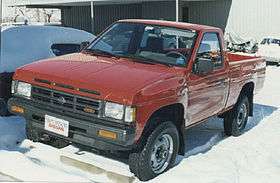 1990 Nissan Hardbody | |
| Overview | |
| Manufacturer | Nissan |
| Also called | |
| Production | |
| Assembly |
|
| Designer | Thomas Semple (1982)[24] |
| Body and chassis | |
| Class | Compact pickup truck (1986–1997) |
| Body style | |
| Layout | FR layout / F4 layout |
| Related | Nissan Pathfinder |
| Powertrain | |
| Engine | |
| Transmission | |
| Dimensions | |
| Wheelbase |
|
| Length |
|
| Width |
|
| Height |
|
| Curb weight | 3,602 lb (1,634 kg) |
| Chronology | |
| Predecessor | Datsun Truck |
| Successor | Nissan Frontier |
The D21 generation was the successor to the Datsun 720, sold as the Nissan Datsun Truck in Japan. The name Navara was used in some markets such as Australia.
Unlike previous generations, this model was available worldwide in two body styles. The "A" body was designed in Japan, and was available in single or dual cab variants, while the "S" body King Cab was designed in the United States, at Nissan's styling studios in San Diego, California.[26] Each version had unique front styling, with the American version having a different hood, and wider flared front guards. In a few countries, such as Australia, both versions were sold. This was also assembled in Greece for the local market, where it was marketed as the Nissan Pickup and King Cab.[20]
In North America, the company used the name "Datsun" from model years 1980 to 1983 then renamed itself "Nissan Datsun" in 1984 and then "Nissan" beginning with the 1985 model year line of trucks and cars alike. Nonetheless, the Nissan pickups continued to be marketed in the Japanese home market as the "Nissan Datsun".[25] The D21 series were called Nissan Hardbody in the United States. "Hardbody" refers to the truck's double-wall bed and overall styling. The Hardbody was produced for the US market from November 1985 until 1997, and were direct competition to the Toyota compact pickup. The move from the 720 to the D21 Nissan series body style changed in January 1986 for the 1986½ model year so the new D21 and later Hardbody can easily be distinguished from the earlier 720 body style by its two large headlights rather than four smaller lights and a less boxy, more aggressive appearance. The Nissan Pathfinder was derived from the Hardbody Truck and started in the same model year with chassis code WD21.
_DX_2-door_cab_chassis_(2011-04-22).jpg)
_4-door_utility_(2010-09-19)_01.jpg)
_4-door_utility_(2010-09-19)_02.jpg)
In the US, the Hardbody cab styles were 'Standard' and 'King' (also known as 'Extended'). Bed lengths were 'standard' 6-foot (2 m) and 'long' seven foot. International markets also received the 'Crew Cab' (four-door) version with a short four and a half foot bed.
Four-cylinder and V6 engines were available. A 2.4-litre four-cylinder Z24i engine was used until 1989 and produced 106 hp in US trim. For many markets a carburetted version of the Z24 was available, usually without much in the way of emissions controls. This model produces 101 PS (74 kW) at 4800 rpm. For North America, this was replaced for the 1990 model year by the KA24E of similar displacement: a SOHC engine of respectable performance. Used in the 1990-1997 models, this engine featured a new three-valve-per-cylinder head and produces 134 hp (100 kW) (The 1990 variant receiving exactly the same engine configuration as the 240SX of the same year). The six-cylinder 3.0-litre VG30i (early years) or VG30E (later years) engine increased power and torque only modestly. It was unavailable in the US starting with the 1996 model year because Nissan was unable to meet the requirements of the new OBD-II emissions law in time.
Five-speed, including overdrive, manual transmissions were the most common, but an automatic transmission was an available option. Both rear-wheel-drive (4x2) and four-wheel-drive (4x4) versions were made in quantity. A limited slip differential was standard on the top 'SE' trim variants.
Major options included air conditioning, larger wheels/tires , sliding rear window, stereo, and rear bumper. There were several trims available including base, XE, and top of the line SE. The XE could be ordered with a 'value package' starting in 1994 which included air conditioning, power mirrors, alloy wheels, and chrome on body trim such as the mirrors and bumpers. The SE was better equipped and could be ordered with the "sport power package" with sunroof, power windows, locks, and mirrors, air conditioning and special 15x8 inch "Robot" alloy wheels.
In 1992, Nissan had a crossover year in which the 1993 model year (mid-1992 to mid-1993 calendar year) had the dashboard of the 1986½–1992 model years with a slightly refreshed body appearance as well as some small interior changes and a revised instrument panel. In a first for the auto industry, this model used the new R134A air conditioning refrigerant.
In 1993, the last major refresh would last through 1997. Changes were a new ergonomic dashboard and much improved interior for 1994.
1995 was the first model year to comply with the new US Department of Transportation "high mount brake light" regulation requiring all trucks to have a brake light in the center of the rear at the top of the cab, though a temporary light was added to the 1994 models.
In late 1995, a driver's side airbag was added as well as compliance with the new US safety rules. Rear wheel ABS came with both 2WD and 4WD models beginning in 1990.
Versions sold in other countries came with a host of more economical engines, ranging from 1.6-litre gasoline fours up to a 2.7-litre diesel four-cylinder, including SD25 and TD25 diesel engines.
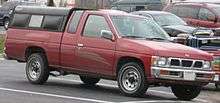
.jpg)
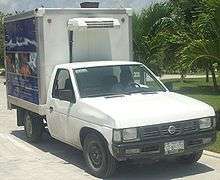
These Hardbody small pickup trucks sold very well worldwide, and are still often seen both on-road and off-road. The V6 engine had a timing belt that requires replacement every 60K miles. In the US, beginning in 1997, the new "D22" was official named, "Frontier" and used a new DOHC 2.4 inline-four borrowed from the Nissan Altima. A newly modified "VG33" V6 was available in 1998 and ending production in the US in 2004. The new VG33E V6 had new, larger, 10 mm exhaust manifold studs in an attempt to decrease the risk of premature exhaust manifold stud failure, but still had limited success.
The D21 design was still available new in some Latin American countries, made in Mexico until the 2008 model year. In its current home country a range of four basic variations of the D21 are sold together as the Nissan Camiones (literally "Nissan Trucks").
Nissan Mexicana ended production of the Camiones on March 15, 2008 after 15 years of production in the Cuernavaca plant.
The Nissan D21 is still being sold in Venezuela as of 2014.[27]
References
| Wikimedia Commons has media related to Datsun trucks. |
- Bent, Alan. "1938 Datsun 17T Truck". earlydatsun.com:The Complete Guide to Classic Datsun Cars and Trucks. Earlydatsun.com. Archived from the original on 26 May 2017. Retrieved 18 November 2017.
- Ozeki, Kazuo (27 April 2017). カタログでたどる日本の小型商用車1904~1966 [Catalog records of Japanese Light Commercial Vehicles: 1904-1966] (PDF) (in Japanese). MIKI Press. pp. 172–173. ISBN 978-4895226684.
- "Datsun 4146 (1950)" (in French). lautomobileancienne.com. 23 July 2015. Archived from the original on 18 May 2016.
- Bent, Alan. "1959 Datsun 220 Model". earlydatsun.com:The Complete Guide to Classic Datsun Cars and Trucks. Earlydatsun.com. Archived from the original on 24 August 2012. Retrieved 27 June 2012.
- Bent, Alan. "1968 Datsun 521 Truck". earlydatsun.com:The Complete Guide to Classic Datsun Cars and Trucks. Earlydatsun.com. Archived from the original on 22 September 2012. Retrieved 27 June 2012.
- Bent, Alan. "1968 Datsun 520 Truck". earlydatsun.com:The Complete Guide to Classic Datsun Cars and Trucks. Earlydatsun.com. Archived from the original on 24 September 2012. Retrieved 27 June 2012.
- New Datsun Pickup 1500 (brochure), Japan: Nissan Motor Co, 1972, p. 2, L61E
- Datsun One Ton Utility (brochure), New Zealand: Nissan Motor Distributors (NZ), 1975, p. 4
- "自動車ガイドブック 1978/1979" [Japanese Motor Vehicles Guide Book 1978/1979] (in Japanese). 25. Japan: Japan Automobile Manufacturers Association. 10 October 1978: 218. 0053-780025-3400. Cite journal requires
|journal=(help) - Wright, Cedric, ed. (September 1978). "Datsun Nissan South Africa uprates its 1978 LCV range". CAR (South Africa). Vol. 22 no. 8. Ramsay, Son & Parker (Pty) ltd. p. 39.
- Datsun saves again in '75 (National Sales Training), 1974, p. 22
- Datsun: La voiture maximum [Datsun: the maximum vehicle] (catalog) (in French), Nissan Automobile Company (Canada) Ltd., 30 August 1975, p. 15, 99999-01099. 100M EP
- Datsun saves again in '75, p. 21
- Datsun saves again in '75, p. 23
- 自動車ガイドブック [Japanese Motor Vehicles Guide Book 1980/1981] (in Japanese), 27, Japan: Japan Automobile Manufacturers Association, 20 October 1980, p. 226, 053-800027-3400
- 自動車ガイドブック [Japanese Motor Vehicles Guide Book '82~'83] (in Japanese), 29, Japan: Japan Automobile Manufacturers Association, 20 October 1982, p. 239, 053-820029-3400
- Matrix 3 Flyer, Nissan brochure 1983
- Nissan Commercial Vehicle Range 1984 (brochure), Worthing, UK: Nissan UK Limited, July 1984, pp. 5–6, S24.25m.F923.7.84
- Isakson, Börje, ed. (22 September 1982). "Två Datsun lättlastare" [Two light Datsun luggers]. Teknikens Värld (in Swedish). Vol. 34 no. 20. Stockholm, Sweden: Specialtidningsförlaget AB. p. 56.
- Donas, Dimitris (28 July 2014). "ΤΕΟΚΑΡ: Όταν οι Ιάπωνες "υποκλίνονταν" στην Ελλάδα" [TEOKAR: When the Japanese "kowtowed" to Greece] (in Greek). news247.gr. Archived from the original on 22 January 2019.
- NIssan Hardbody brochure, importarchive.com Retrieved 17 October 2019
- แกะรอยกระบะนิสสัน(3)เปิดตำนานบิ๊กเอ็ม (in Thai). Manager Online. 27 April 2007. Retrieved 2 June 2011.
- http://www.zznissan.com.cn/ official Website of Zhengzhou-Nissan
- https://articles.latimes.com/1986-03-23/magazine/tm-5460_1_american-cars/3
- Datsun: ニューパワーNA20、NA16新型ガソリンエンジンシリーズ搭載 (Catalog) [Datsun: New Power with new NA20/NA16 gasoline engine series] (in Japanese), Nissan, March 1990, p. 15, C1171-0033AGK
- https://trove.nla.gov.au/newspaper/article/185639845?searchTerm=navara%20%20%20%20%20%20%20%20%20%20%20%20&searchLimits=exactPhrase%7C%7C%7CanyWords%7C%7C%7CnotWords%7C%7C%7CrequestHandler%7C%7C%7CdateFrom=1986-01-01%7C%7C%7CdateTo=1986-12-31%7C%7C%7Csortby
- "Archived copy". Archived from the original on 16 October 2014. Retrieved 9 October 2014.CS1 maint: archived copy as title (link)